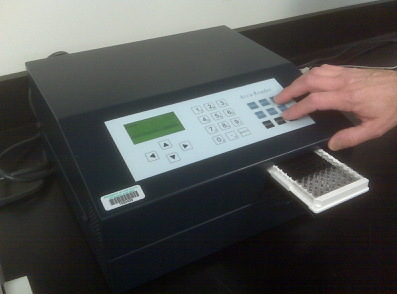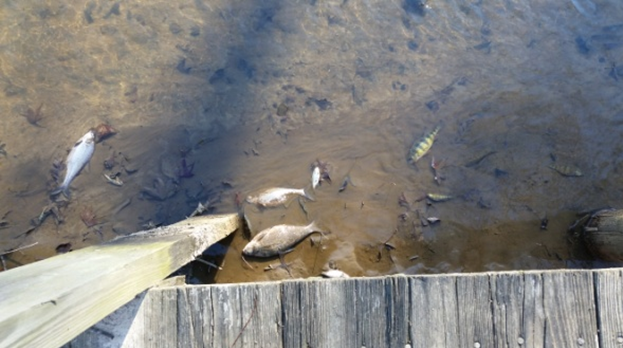General Information
Harmful algal blooms, or HABs, occur when algae—simple photosynthetic organisms that live in salt water and freshwater—grow out of control while producing toxic or harmful effects on people, fish, shellfish, marine mammals, other aquatic life, or birds. The human illnesses caused by HABs, though rare, can be debilitating or even fatal. HABs have been reported in every U.S. coastal state, and their occurrence may be increasing
. HABs are a national concern because they affect not only the health of people and marine ecosystems, but also the 'health' of local and regional economies.
Appearance of a Bloom
Algae are an important part of aquatic ecosystems and form the basis of aquatic food webs. Most are not toxic. There are many types of algae commonly found in Maryland. Individual algal cells cannot be seen with the unaided eye; however, under certain conditions they can reproduce and concentrate into visible concentrations called blooms.
Harmful Algal Blooms in Maryland
In Maryland, Microcystis spp. is the most commonly observed freshwater toxic algae. It produces the toxin microcystin. Several Microcystis species routinely appear in Maryland's tidal freshwater portions of the tributaries to the Chesapeake Bay, in addition to several freshwater lakes and ponds throughout the state.

The Maryland Department of the Environment (MDE) utilizes Enzyme Linked Immuno Sorbent Assay equipment (ELISA) to quickly assess public health threats associated with several algae toxins, including microcystin.
Blooms of blue-green algae, including Microcystis, may be indicative of nutrient rich environments. These blooms resemble a greenish, thick, paint-like (sometimes granular) material that accumulates along shores. Scums that accumulate on the shores of lakes may contain high concentrations of toxins (including microcystin), which allows the toxins to dissolve in the water even when the cells are no longer alive.
Factors that contribute to a Harmful Algal Bloom
Nutrients – primarily nitrogen and phosphorus – when in excess allow normal background levels of algae to grow into blooms. Light availability, water temperature, flow conditions, water chemistry, pH changes and trace mineral concentrations also influence when and where a bloom may occur. Sources of the excessive nutrients vary by watershed, from point sources such as waste water facilities to non-point sources including urban, suburban or agricultural runoff. To reduce the occurrence of HABs in your area, take action to reduce nutrients reaching your nearby waterway. Environmental Protection Agency (EPA) lists many ways that you can reduce
nutrient pollution.
Health Effects
Different kinds of algae toxins cause different types of
health effects. For instance, the most common blue-green algae toxin of concern (microcystin) can cause gastroenteritis and liver damage. Seek medical treatment right away if you think you or someone you know might have been poisoned by bluegreen algae toxins.
Maryland’s Beaches
At designated
beaches where a harmful bluegreen algal bloom exists, MDE works with Maryland Department of Health (MDH), Maryland Department of Natural Resources (DNR) and local health departments to ensure that users are advised of risks associated with that bloom. Monitoring of water quality will continue until levels are below the action levels or until the bloom is no longer visible.
Drinking Water
Drinking water supplies are monitored for a variety of contaminants, including HAB toxins, to assure that all Marylanders have a safe and adequate supply of
drinking water.
Fishing and Crabbing
Some blue-green algae toxins may accumulate in fish and crabs, primarily in the internal organs such as the liver and kidneys, or hepatopancreas (mustard) in crabs. Toxin accumulation studies show that the muscle (
fillet) tissue is less affected by blue-green algae toxins.
If you decide to eat fish caught from waters affected by a blue-green algal bloom, remove the fat, skin and organs before cooking. Be careful not to cut into the organs. Before cooking or freezing the fish, rinse the fillets with clean water to remove any contaminants from the cleaning process. If you decide to eat crabs caught from water affected by a blue-green algal bloom, remove the hepatopancreas or mustard.
Maryland’s Shellfish Harvesting Waters
MDE and DNR routinely monitor shellfish harvest waters for the types of harmful algae of concern for human health that can accumulate in oyster and clam meats. If certain known toxin producing algae are present in high numbers, oyster or clam samples are collected and toxin levels in shellfish meats are analyzed for toxin.
A dinoflagellate called
Dinophysis spp., which produces the biotoxin
okadaic acid, has been present in Maryland’s coastal bays at low levels for a long time. When blooms of
Dinophysis are present, MDE routinely screens shellfish meats for this toxin to prevent Diarrhetic Shellfish Poisoning (DSP).
Maryland’s Harmful Algal Bloom Monitoring Program
Some harmful algae, (e.g.,
Karlodinium veneficum) release toxins that kill fish but do not adversely affect public health. Other nuisance algae species (e.g.
Prorocentrum minimum,
Gyrodinium uncatenum) are not known to be toxic in Maryland, but may occasionally bloom to high enough levels to cause
fish kills resulting from high Bio-chemical Oxygen Demand (BOD). In Maryland, several algae species may produce toxins that affect public health either through direct contact with or ingestion of contaminated water, or through consumption of contaminated shellfish. Local algae species that potentially constitute a public health concern include
Microcystis aeruginosa,
Dinophysis acuminata, and
Pseudonitzschia spp. These species are routinely monitored in Maryland specifically to protect public health. The State is also on the lookout for new HAB species that have the potential to migrate into Maryland waters.

MDE,
MDH,
DNR and other investigators collaborate to manage a State-wide HAB surveillance program. This program includes bloom detection, field response, laboratory analysis, and management actions as appropriate to protect public health and the environment. MDE, MDH, and DNR coordinate with the local health departments, U.S. Food and Drug Administration (FDA), researchers at regional universities, the Center for Disease Control and Prevention (
CDC), and U.S.
EPA to assure that swimming and recreational waters are monitored, that shellfish waters are free of bioaccumulating algae toxins, and that drinking water supplies are protected.
If You See A Bluegreen Algal Bloom:
When bathers see bright green waters, sometimes with a surface scum that resembles green paint, they are advised to take the following precautions:
- Do not swim in areas where a bloom of blue-green algae is evident;
- Do not drink/cook with suspected water. In-home treatments like boiling, chlorine bleach or water filtration units offer little protection from HAB toxins;
- If contact is unavoidable, wash off with clean water;
- If you feel unwell or skin irritation persists, see a physician or healthcare provider;
- Keep pets and livestock away from bloom areas; and
- Contact your veterinarian for sick pets.
Contact Us
If you have quesitons about HABs in Maryland, you can contact MDE staff by calling (443) 482-2731 or (443) 482-2710.
Resources